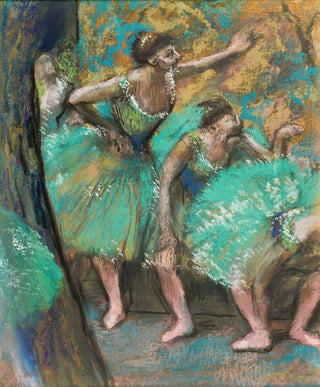Art print | Les danseurs - Edgar Degas


View from behind

Frame (optional)
In the fascinating world of art, some works transcend time and space, captivating viewers and evoking emotions. "Les danseurs" by Edgar Degas is undoubtedly one of these iconic pieces that evoke grace and the beauty of movement. This artwork, created at the end of the 19th century, captures a fleeting moment in the world of dance, revealing the passion and discipline of artists in full effort. The art print Les danseurs - Edgar Degas allows you to appreciate this vibrant scene, where bodies intertwine in a delicate ballet, while offering a window into the very soul of dance.
Style and uniqueness of the work
Edgar Degas's style is characterized by an innovative approach and a keen sense of observation. In "Les danseurs," he uses daring viewpoints and dynamic compositions that seem almost photographic. The way he plays with light and shadow gives a particular depth to each character, making their movement almost tangible. Degas does not merely depict dance; he captures its essence, energy, and melancholy. The colors, subtly chosen, evoke an atmosphere that is both intimate and vibrant, while the gestures of the dancers tell a story beyond simple postures. The fluidity of lines and the delicacy of strokes demonstrate unparalleled technical mastery, making this work a true masterpiece.
The artist and his influence
Edgar Degas, a major figure of the Impressionist movement, established himself through his unique approach and artistic vision. Born in Paris in 1834, he was deeply influenced by urban life and the spectacles of his time. His fascination with dance, particularly with the Paris Opera, gave rise to a series of works exploring the beauty and complexity of the body in motion. Degas was not limited to dance; he also explored other art forms such as painting, pastel, and sculpture. His influence extends far beyond his time, inspiring many contemporary and future artists to explore similar themes. By incorporating elements of everyday life into his work, he opened

Matte finish

View from behind

Frame (optional)
In the fascinating world of art, some works transcend time and space, captivating viewers and evoking emotions. "Les danseurs" by Edgar Degas is undoubtedly one of these iconic pieces that evoke grace and the beauty of movement. This artwork, created at the end of the 19th century, captures a fleeting moment in the world of dance, revealing the passion and discipline of artists in full effort. The art print Les danseurs - Edgar Degas allows you to appreciate this vibrant scene, where bodies intertwine in a delicate ballet, while offering a window into the very soul of dance.
Style and uniqueness of the work
Edgar Degas's style is characterized by an innovative approach and a keen sense of observation. In "Les danseurs," he uses daring viewpoints and dynamic compositions that seem almost photographic. The way he plays with light and shadow gives a particular depth to each character, making their movement almost tangible. Degas does not merely depict dance; he captures its essence, energy, and melancholy. The colors, subtly chosen, evoke an atmosphere that is both intimate and vibrant, while the gestures of the dancers tell a story beyond simple postures. The fluidity of lines and the delicacy of strokes demonstrate unparalleled technical mastery, making this work a true masterpiece.
The artist and his influence
Edgar Degas, a major figure of the Impressionist movement, established himself through his unique approach and artistic vision. Born in Paris in 1834, he was deeply influenced by urban life and the spectacles of his time. His fascination with dance, particularly with the Paris Opera, gave rise to a series of works exploring the beauty and complexity of the body in motion. Degas was not limited to dance; he also explored other art forms such as painting, pastel, and sculpture. His influence extends far beyond his time, inspiring many contemporary and future artists to explore similar themes. By incorporating elements of everyday life into his work, he opened






